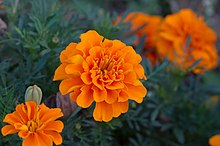Tagetes
Tagetes (/tæˈdʒiːtiːz/) is a genus[3] of 50 species of annual or perennial, mostly herbaceous plants in the family Asteraceae.
[4][5] Originally called cempōhualxōchitl, by the Nahua peoples, these plants are native to Central and Southern Mexico and several other Latin American countries.
Blooms naturally occur in golden, orange, yellow, and white colors, often with maroon highlights.
Marigolds are recorded as a food plant for some Lepidoptera caterpillars including the dot moth, and a nectar source for other butterflies and bumblebees.
[14] The species Tagetes lucida, known as pericón, is used to prepare a sweetish, anise-flavored medicinal tea in Mexico.
[16] Tagetes minuta, native to southern South America, is a tall, upright marigold plant with small flowers used as a culinary herb in Peru, Ecuador, and parts of Chile and Bolivia, where it is called by the Incan term huacatay.
Having both "green" and "yellow/orange" notes, the taste and odor of fresh T. minuta is like a mixture of sweet basil, tarragon, mint and citrus.
The marigold is also widely cultivated in India and Thailand, particularly the species T. erecta, Tagetes patula and T. tenuifolia.
Vast quantities of marigolds are used in garlands and decoration for weddings, festivals, and religious events.


